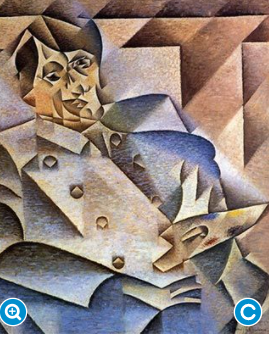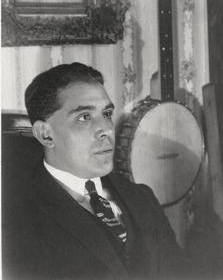
J uan Gris the leading artist in Cuban painting was born Jose Victoriano Carmelo Carlos Gonzalez-Perez in Madrid in 1887. He was the thirteenth of fourteen children. He attended Madrid’s Escuela de Artes Y Manufacturas from 1902-1904. He studied math, physics, and mechanical drawing. He decided he liked drawing and decided to study art.
uan Gris the leading artist in Cuban painting was born Jose Victoriano Carmelo Carlos Gonzalez-Perez in Madrid in 1887. He was the thirteenth of fourteen children. He attended Madrid’s Escuela de Artes Y Manufacturas from 1902-1904. He studied math, physics, and mechanical drawing. He decided he liked drawing and decided to study art.
His art teacher was Jose Moreno Carbonero a respect artist in Madid who taught Salvador Dali and Picasso. It was in 1905 when Gonzalez-Perez changed his name to Juan Gris. After his father’s death, he sold all his possessions and moved to France where he remained. He could not return to Spain since he did not go into the military and didn’t have any papers.
During his early years in Paris, he worked as an illustrator and satirical cartoonist for a variety of magazines and periodicals. He settled in the Montmartre artist commune Bateau Lavoir, where he met Picasso, Braque, Matisse, and the American writer Gertrude Stein.
 In 1912, he exhibited at the Salon des Independants in 1912. That same year, he signed a contract that gave the German art dealer Daniel-Henry Kahnweiler (who also worked with Picasso and Braque) the exclusive right to sell his work.
In 1912, he exhibited at the Salon des Independants in 1912. That same year, he signed a contract that gave the German art dealer Daniel-Henry Kahnweiler (who also worked with Picasso and Braque) the exclusive right to sell his work.
From 1914 onward departing from Picasso and Braque, his work from the latter period is distinguished by its move away from shattering abstraction and use of bright, harmonious colors in daring combinations.
At the beginning of World War I, he received financial help from Gertrude Stein. He spent time with Matisse in his studio at Collioure, in the south of France. In 1916, he signed a new contract with French art dealer Leonce Rosenberg, another hugely influential collector of modernist art. His work from the early war years examines the interplay between objects and their shadows, and reintroduces complicated planar intersections, sumptuous colors and textures.
 Toward the end of the war, he spent several months in Touraine, the native region of his French wife Josette. This period focuses on depictions of traditional peasant figures, linking him to a broader shift among European artists during and after the war.
Toward the end of the war, he spent several months in Touraine, the native region of his French wife Josette. This period focuses on depictions of traditional peasant figures, linking him to a broader shift among European artists during and after the war.
He was awarded his first major solo exhibition at Rosenberg’s Galerie l’Effort Moderne in Paris in 1919. The following year, he participated in the final major exhibition of Cubist painters at the Salon des Independants.
In 1920 he became ill with pleurisy., he spent the winter at Bandol, on the southeastern coast of France. While there, he spent time with the Russian ballet impresario Sergei Diaghilev, and the two discussed ideas about staging and costumes for upcoming productions. Their conversations eventually yielded a full collaboration, with Gris designing costumes and sets for the Ballet Russes from 1922 to 1924.
Major exhibitions of his work took place at the Galerie Simon in Paris and the Galerie Flechtheim in Berlin in 1923, and at the Galerie Flechtheim in Düsseldorf in 1925. It was during these years that he achieved the peak of popularity and renown that he would know in his lifetime. He was also making his most forceful articulation of his theories on art and aesthetics, delivering his lecture, ‘Des possibilites de la peinture’ at the Sorbonne in 1924. In it, he describes his belief that a painting was not merely a representation of an object from reality, but something that the artist recreates and reinterprets through his craft.
In 1922, he moved out of central Paris to the suburban area of Boulogne-sur-Seine, to try and cure his asthma. From late 1925 onward, he battled consistent kidney and cardiac ailments. He died in 1927 of kidney failure, leaving behind his wife and young son. He was only 40 years old. In response to Gris’s death, Stein wrote a memorial titled The Life and Death of Juan Gris, in which she describes him as “a perfect painter.”
Thank you for reading my article
Copyright Linda Meckler 2021